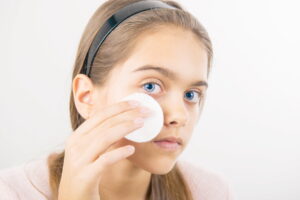It is common practice at your regular OBGYN appointment for your doctor to perform a breast
exam, by using their hands and examining the overall the look of your breasts. Though this is no
substitute for a mammogram, which adult women are advised to have done yearly, it is a useful
method to see whether there are any visible or tactile abnormalities on your breasts. In fact, 40%
of breast cancers were diagnosed because women noticed something unusual about their breasts.

Is this something I can do at home?
Absolutely—and it is a good idea to perform a self-breast examination once every month. Consider it a monthly inspection you deserve, and one that at the very least helps you learn your body better. Using your eyes and hands for this examination, you can develop your own breast awareness and be able to immediately identify changes—should there be any, fingers crossed not!
What do I do?
First and foremost, it is important to choose a time of the month when your breast will not be as tender since this can cloud the results of the inspection. Ideally, during a time when you are not menstruating or ovulating. Secondly, remember you can (and probably should) ask your doctor or nurse practitioner for a demonstration on how to do this at home.
The most effective technique is to start with a visual examination of your breasts. Stand shirtless and braless in front of the mirror, with no-shadow casting light if possible, and place your hands at your sides. Look for any changes in size, shape, possible asymmetry, dimpling, or puckering. Check to see if your nipples are inverted. Then, inspect your breasts in a similar manner but after raising your hands above your head, palms pressed together forming an A shape. You can also lift your breasts and inspect whether the ridges on the bottom are symmetrical. Should you not trust your own vision, or if you have a visual impairment, it’s a good idea to ask a partner, trusted family member or friend, to help you with this.
Is this all?
The visual inspection is the first step. Next, you want to use the pads of your three middle
fingers. If you can’t sense very well with the pads of your fingers you can use your palm or the
backs of your fingers. You can do the tactile inspection in the shower or lying down (that way,
the breast tissue spreads and it’s easier to feel).
Now, take your time, don’t rush, and establish a routine for this part. If you do it clockwise every
time, for example, and in the same order, then after a few times you will be better able to judge
any changes in the pattern of your breasts. The goal here is to feel the depths of the breast using
different levels of pressure—so you can go over the whole tissue. Closest to the skin, use light
pressure. As you go try to feel a little deeper, use medium pressure. Closest to the chest and ribs,
use firmer pressure.
Remember that you are not looking for anything in particular, you are just learning the patterns
of your breasts. So, take deep breaths, take your time, remind yourself this is being done
absolutely for preventative reasons—just like flossing!
More
By Iris Farrou
07 Sep, 2022
Breast health, Breastfeeding support, Health Conditions and Pregnancy, Lifestyle Tips, Mental Health, New Moms, Prevention, Procedures, Queer Health, Reproductive health, Women's Health, Young adults & teens
BRCA Gene, Breast cancer prevention, Breast cancer screening, Breast Exam, Breast Exam Buffalo NY, Breast Exams at Home, Buffalo NY, Buffalo OB-GYN, Cancer in women, Healthy Lifestyle, Self-Exam, Self-Examination, women's health tips
The most common gynecological care procedure may be the Pap Smear—and it’s no secret that
it revolutionized women’s health and made it widely accessible—but a close second is cervical
cancer screening. Now, don’t let the words scare you: it doesn’t mean you have to get this
screening done if you are suspecting you have cancerous cells. It simply means this screening
tests specifically for evidence of HPV in the uterine cervix. A Pap Smear, on the other hand, tests
for precancerous cells on the cervix—cells that may turn cancerous if not treated correctly.

How does it happen?
Cervical cancer screening is a similar procedure to a Pap Smear: they both happen in a clinic, a
medical office, or a community health center. It’s common to get those tests done during a pelvic
examination. Much like the Pap Smear, using a vaginal speculum, the medical professional will
collect cells and mucus from the cervix and vagina and send them for lab testing. A Pap Smear
checks to see if the cells look generally normal. A cervical cancer screening specifically tests the
cells for HPV.
Why do I need it?
Remember the primary goal of a cervical screening is to routinely look for abnormal cervical
cells with severe cell changes so they can be removed, and cancerous cells can be stopped from
developing. It is a routine examination for anyone who has a uterine cervix and is sexually
active. Nearly all types of cervical cancer are caused by sexually transmitted HPV. A secondary
goal of this screening is to identify cervical cancers at an early stage so they can be treated
successfully and avoid further problems.
When should I get tested?
Most sources suggest that you should start getting Pap Smears and Cervical Screenings after the
age of 21. However, many people are sexually active before that age—you should be getting
regular routine examinations as soon as your become sexually active. The standard suggestion is
to be screened every 3 years, considering your results come back normal, but if you have
personal concerns and the ability to be tested every year—better safe than sorry!
If you are older than 65 and have had regular tests and satisfying results for several years in a
row or have had your cervix removed for non-cancer related reasons, you may not need to be
screened anymore. However, that is still a personal decision, and you are entitled to be keeping
as many tabs on your health as you want.
More
By Iris Farrou
05 Aug, 2022
Lifestyle Tips, Prevention, Procedures, Queer Health, Reproductive health, Sexual health, Women's Health
BRCA Gene, Cancer Screening, Cervical Health, how often pap smear, How often should you see OBGYN, HPV, Pap smear, Regular STD Testing, Screening, Test, When Should I Start Seeing a Gynecologist

Our physical and mental health is directly connected to regular, healthy, and enjoyable
socialization with friends and family, colleagues, people who share our hobbies and interests…
With COVID-19 severely affecting our socialization levels, many found themselves with
increased loneliness, anxiety, and depression—thus bringing down their immune system and
overall physical health. However, it is a harsh truth that elders suffered from isolating and social
distancing extremely more than younger people.
Unfortunately, elder isolation and loneliness is not solely a COVID-related phenomenon. A
study by UCSF found that more than 40% of seniors regularly experience loneliness. The same
study also drew direct connections between loneliness, serious health issues, and death among
the elderly population. One can only imagine how much worse this got during COVID isolation.
Health Issues
Individuals with low social interaction levels are more likely to suffer from anxiety and
depression, and experts have found direct links between loneliness and suicide. Senior
individuals with limited social lives have also been found to suffer from worsened dementia and
Alzheimer’s disease—or rapid progression compared to elders with a rich social life—coronary
artery disease, heart failure, and increased risk of stroke.
Benefits of Socialization
The good news is that socializing helps combat most, if not all, of the health issues loneliness
creates. A social life can benefit elders because it:
- Increases mental awareness: when we interact with others, we remain connected to the
outside world and keep our cognitive abilities sharpened. After all, the brain is a muscle.
- Fights anxiety and depression: though these may be chronic conditions, socializing helps
keep anxiety and depression at bay—especially if both are related to ageing. At the very
least, it proves that others care and helps build a community.
- Support system: elder socialization reminds us there is a community of same-aged
people, as well as friends and family, who are present for emotional and physical help.
- Physical discomfort relief: though physical pain can be very sharp, socialization provides
a break from a lonely routine, gets us going, and takes our mind off of aches—even for a
little while.
Overall, elder socialization not only creates a healthier quality of life and has the potential to
extend life. With technology seniors can be closer to their loved ones much more easily: daily
use of social media, adopting a pet for companionship, utilizing companion services, trying to
enjoy meals socially, participating in local activities (if possible) and ensuring reliable
transportation are just some of the ways that eliminate elder social isolation.
More
By Iris Farrou
05 Aug, 2022
Geriatric Mental Health, Lifestyle Tips, Mental Health, Prevention, Uncategorized, Women's Health
aging parents, Depression, Depression symptoms, Elderly, Geriatric, isolation, Loneliness, Mental Health, Socialization
What is it?
Multiple Sclerosis (MS) is an autoimmune disease that affects the central nervous system, mainly
the brain and the spinal cord. Like most autoimmune conditions, research remains inconclusive
on what causes it, other than: antibodies attack healthy tissue. In MS, your body attacks the
myelin sheath: the wiring protecting your nerve cells. This damage causes messages from your
brain to the rest of your body to slow down, or completely stop. Most common treatment for MS
is a Disease Modifying Therapy (DMT), tailored to the patient’s needs and the severity of the
condition.

DMTs and Pregnancy
Women who have been diagnosed with MS and are thinking of becoming pregnant have likely
been told that most DMTs are not safe to use during pregnancy. One of the most common
concerns with stopping DMTs is the risk of relapse after pregnancy. In fact, medical
professionals suggest you stop the therapy altogether once you embark on your pregnancy
journey.
Another research, however, has found that 12% of its women participants were taking a
DMT during the first trimester. This lowered to 3% of participants by the third trimester. This is
not to say that use of DMTs during pregnancy is safe, but it does point to the need for further
research.
What should I expect?
It’s common that during pregnancy most autoimmune diseases—including MS—quiet down:
you may not experience as many symptoms, or your symptoms may lessen. Researchers believe
this is due to the hormones your body produces during pregnancy.
There is no evidence MS causes any miscarriages, stillbirths, or congenital malfunctions. Some
research suggests that premature labor and the risk of infections have been found to be slightly
higher in women with MS. Your doctor may suggest closer monitoring of your pregnancy, more
prenatal visits, and further tests to ensure your health. It’s possible you may need to consider a
C-section, especially if your MS symptoms affect your pelvic muscles and nerves.
What about relapse?
Research has found that the risk of relapse is relatively low during pregnancy. However, it can be
treated with corticosteroids which are generally known to be safe during the first and second
trimester.
After giving birth, studies have found an increased chance of relapse in the first three months. A
significant factor is the stability of the disease prior to pregnancy, and it is used to reduce this
risk. Similar to use of corticosteroids, if you are thinking of breastfeeding, remember that DMTs
can also pass through breastmilk—their use is not recommended if you will be breastfeeding.
More
By Iris Farrou
05 Aug, 2022
Health Conditions and Pregnancy, Lifestyle Tips, Pregnancy, Prevention, Reproductive health, Uncategorized
Autoimmune, Common pregnancy complications, Disease Modifying Therapy, DMTs, Healthy Pregnancy with MS, MS, Multiple Sclerosis, Pregnancy
 By the third trimester of pregnancy, you are probably already used to an overall discomfort and a changing body, but it is quite common that pains and aches become much more prevalent in the last three months before your due date! Don’t worry, there are ways to address this discomfort and make your body and soul feel more comfortable and relaxed to welcome your new baby.
By the third trimester of pregnancy, you are probably already used to an overall discomfort and a changing body, but it is quite common that pains and aches become much more prevalent in the last three months before your due date! Don’t worry, there are ways to address this discomfort and make your body and soul feel more comfortable and relaxed to welcome your new baby.
Some Common Symptoms
Several of the symptoms you experience during the second trimester may continue into the third one, though many women report that morning sickness is not as prevalent. Your baby is growing and pushing on your organs more and more, so despite your own discomfort, the aches are actually a good sign! Many women report that they have difficulty breathing or have to go to the bathroom more often. Pressure on your pelvis, more of the baby kicking, as well as heartburn are also common symptoms of the third trimester. Swelling in your fingers and ankles, breast tenderness, and a protruding belly are also to be expected!
Self-Care
It’s important to have at least five appointments set up with your healthcare provider in the third trimester of your pregnancy: at 30 weeks, 34, 36, 38 and 40. Since heartburn is very prevalent, try to manage your diet so you consume foods that are less acidic and help balance your stomach and gut health. Though antacid preparations can be used, it is advised that they do not become the standard.
Troubled sleep can cause you to feel exhaustion but try to stay away from sleeping pills. A warm bath before bed can help you relax and ease your aches and a cool temperature in your space will help you not overheat. Try using a body pillow to support you while you’re sleeping, or smaller pillows to support specific areas and ease the tension while you sleep.
False Contractions
It’s quite common that your body will try to prepare you for labor towards the end of your pregnancy by creating false contractions. These are also called “Braxton Hicks” and resemble menstrual cramps or a tightening in the abdomen. There is no specific treatment for those, but you can change your body’s position, try some light yoga or light exercise to relax, nap if you can, and drink water. If those persist or even become stronger, it may be time to contact your doctor!
More
 Living in a world that is becoming increasingly busy and fast-paced necessitates that we remain active, or even hyperactive, for long amounts of time. Just because that has become the standard, however, does not mean we should accept exhaustion and low energy levels—especially if we feel this way the majority of the time—as the standard. It is understandable that women may face even more responsibilities in their daily lives, trying to balance their work life and families, personal life, and friendships, as well as the duties of motherhood. But constant exhaustion experienced by someone who is generally healthy, and lives a generally healthy lifestyle, is a cause for concern.
Living in a world that is becoming increasingly busy and fast-paced necessitates that we remain active, or even hyperactive, for long amounts of time. Just because that has become the standard, however, does not mean we should accept exhaustion and low energy levels—especially if we feel this way the majority of the time—as the standard. It is understandable that women may face even more responsibilities in their daily lives, trying to balance their work life and families, personal life, and friendships, as well as the duties of motherhood. But constant exhaustion experienced by someone who is generally healthy, and lives a generally healthy lifestyle, is a cause for concern.
Here are some of the possible factors that may be contributing to constant fatigue and low energy:
Poor Quality Sleep: even if our busy lifestyle keeps us on our toes, adults actually need seven to eight hours of sleep a night, but that is rarely the case. However, establishing a sleep schedule that revolves around going to bed at the same time and waking up at the same time every day can be very beneficial to prevent exhaustion. It is important to sleep in a cool, dark, place with limited distractions and preferably no electronics.
Sleep Apnea: pretty close to the poor quality of sleep many adults experience is the phenomenon of sleep apnea. This is a condition that can make quality sleep almost impossible, characterized by snoring and interrupted breathing. Even if you end up sleeping through the night, it’s likely you’ll still be drowsy during the daytime, which leads to exhaustion.
Thyroid Problems: they most commonly affect women, especially middle-aged women. In addition to affecting your heart rate and metabolism, a hyperactive thyroid can cause you to feel burnt out. On the other hand, an underperforming thyroid can make you feel sluggish. If you are suspecting this is the cause of your exhaustion, discuss thyroid replacement hormone options with your doctor.
Iron Deficiency: this is a pretty common condition among women, as menstruation, pregnancy, and menopause cause female bodies to need more iron. Actually, few women get the amount of iron they actually need many times leading to anemia. Anemia’s most common symptoms are fatigue and weakness.
Before you venture into medical explorations, it is also advised that you consider lifestyle factors that may be affecting your energy levels. For example, excess physical activity can cause you to feel exhausted, and a sedentary lifestyle may cause you to feel weak and fatigued. Alcohol or drug use, as well as medications like antihistamines or cough syrup, can also lead to feeling tired. Unhealthy eating habits or an unbalanced diet are likely to contribute to general exhaustion.
More

We’re all familiar with the contraceptive method that changed the world: the pill. Beautiful as this invention was, couples are seeking newer and better methods of contraception—and many of those methods are nonhormonal. Most common: barrier methods like condoms or cervical caps, spermicides, IUDs, and sterilization. Most of them: focused on women. Few are the contraceptive methods that are focused on men or have any effect on their lives overall—use of condoms, or vasectomy.
Phexxi
In May 2020, the Food and Drug Administration gave us a new hope for nonhormonal contraceptive methods. A vaginal gel called Phexxi was approved. It is a birth control gel available by prescription and it is placed in the vagina before penis-in-vagina intercourse occurs to prevent pregnancy. Essentially, it makes the vagina inhospitable to sperm by maintaining its pH to an acidic level. Usually, vaginal pH is around 4, and rises to about 7 when semen enters the vagina to create a more protective environment for sperm. Phexxi keeps the vagina in the more acidic levels, almost paralyzing the sperm and preventing pregnancy.
- Ingredients: Phexxi consists of 3 active ingredients that are all naturally found—lactic acid which is produced by the vagina and can be found in dairy products, citric acid which can be found in citrus fruits, and potassium bitartrate which many of us know as cream of tartar (also a byproduct of winemaking)
Who uses it?
People who can become pregnant, but wish to avoid it without the use of hormones, can use this contraceptive product. There are also numerous other benefits such as ease to start and stop using, it doesn’t have to be used every day, it won’t affect your long term fertility, it can be used discreetly and multiple times a day, can be used in the moment and at any time during your menstrual cycle, and can also be used in combination with some other contraceptive methods (but not all).
Downsides?
According to Planned Parenthood, some ingredients in spermicide contraceptive may irritate sensitive genital tissues, giving infections a way into your body. Consequently, this increases the chances of HIV and other STDs being contracted. Along with this danger it should be noted that Phexxi does not actually protect you against STDs, and for that reason it should be used in combination with condoms.
If you or your partner are sensitive or allergic to the gel’s active ingredients, you should definitely avoid using it. Similarly, if you have a history of UTIs or other urinary problems, you should explore other options first. Though you can use condoms or other barrier methods with the gel, if you are using a vaginal ring you should not use Phexxi.
More
 Probably every parent’s concern is that their child is developing in the best possible, healthy way. You may have heard of developmental milestones, but what do they really mean?
Probably every parent’s concern is that their child is developing in the best possible, healthy way. You may have heard of developmental milestones, but what do they really mean?
First and foremost is important to remember that every age has different developmental characteristics and milestones you should keep an eye on. When it comes to a newborn, parents are mostly keeping track of movement, visual and hearing, and social and emotional milestones. When you have a toddler, you start paying attention to hand and finger skills, as well as language and cognitive development.
Why is it Important?
The CDC reports that 1 in 6 children aged 3-17 have at least one developmental, or behavioral, disability. The problem is that many children are not diagnosed until they are in school, by which time the window of opportunity for important treatments may have passed, and significant delays may have taken place. The good news is there are ways for you to monitor your child’s development! The CDC offers not only a Checklist by age, but also a Milestone Tracker App you can use.
The Process
- Monitoring
Developmental milestones can easily be monitored at home, with the help of some simple resources. Remember that what they refer to are things about 75% of children can do by a certain age. You can observe how your child grows and changes over time, and whether they meet the typical milestones of their age.
- Screening
If you have concerns, or notice a milestone is missed, then you can proceed with developmental screening, a closer look, and a test to see how your child is developing. Though it can be a part of regular health screenings, a doctor can use a questionnaire and checklist to monitor your child’s progress in language, thinking, movement, behavior, and emotions. The American Academy of Pediatrics suggests developmental and behavioral screenings at ages of 9, 18, and 30 months, regardless of concern. In addition, it is recommended that all children be screened for autism spectrum disorder at 18 and 24 months.
- Evaluation
Should an area of concern be found, then your medical professional will usually proceed with a developmental evaluation to try and reach a diagnosis. These are done by trained specialists, such as a developmental pediatrician, child psychologist, or speech-language pathologist, among others. The specialist will observe the child, speak with the caretakers or parents, and even give the child a structured test. Usually, developmental evaluations determine whether a child needs early intervention services or special treatments.
More
 We associate night sweats and hot flashes with menopause. If anything, they are the tell-tale signs that a woman is premenopausal. However, there can be other factors that cause night sweats in women, who seem to experience them more often than men, according to the Sleep Foundation.
We associate night sweats and hot flashes with menopause. If anything, they are the tell-tale signs that a woman is premenopausal. However, there can be other factors that cause night sweats in women, who seem to experience them more often than men, according to the Sleep Foundation.
Hormones and Thermoneutral Zone
The thermoneutral zone is the range of temperatures a body is comfortable with. For example, our body causes shivers to keep us warm and it sweats to cool us down we stay within this zone. Sometimes, when a bodily process impacts the thermoneutral zone, we may experience night sweats.
Changing hormone levels in our body are one of the bodily processes that cause variations in our thermoneutral zone. Women in perimenopause or in menopause experience severe drops in their estrogen and progesterone levels, but similar hormonal changes also happen during menstrual cycles: sweating and hot flashes can be symptoms of premenstrual syndrome (PMS).
When Does it Happen?
You can except a slight increase in your body temperature, which often goes unnoticed, around the 14th day of your cycle, when progesterone levels go up. When those rise, estrogen levels fall. The decrease of estrogen affects your hypothalamus, which is responsible for keeping your body temperature at a steady level. At the same time, your brain produces more norepinephrine and other hormones. Though this is not a negative function, those hormones make you more sensitive to even the slightest changes in body temperature. As a result, your body sweats to cool off even if it’s not really necessary.
How to Deal With it
Since these hot flashes and night sweats are not the result of menopause, you may be able to deal with them in simple ways and by using home remedies.
- Try to keep cool, and continue keeping cool, by dressing in layers. That way, you can remove or add layers as needed. Adjust the room temperature if possible, using fans or opening windows.
- Be careful with eating hot, spicy, foods that may raise your body temperature. So can caffeine and alcohol, so it may be best to avoid or minimize them.
- Smoking is also linked to increases in body temperature, amidst other harmful results. It is definitely worth keeping that one in mind and removing it from your life.
- If you are overweight, it is possible that this is connected to night sweats and hot flashes.
Though the evidence is inconclusive, some women find relief through alternative medicine, such as mindfulness meditation, acupuncture, cognitive behavioral therapy, and even hypnosis. It’s worth a try if it may help you sleep better!
More
 Every parent expects their sweet babies will one day grow into hormonal teenagers, with changes in their appearance and their attitude. Some dread this change, but it’s none other than teens themselves who have to deal with their bodies changing, smelling differently, and deal with skin care and acne!
Every parent expects their sweet babies will one day grow into hormonal teenagers, with changes in their appearance and their attitude. Some dread this change, but it’s none other than teens themselves who have to deal with their bodies changing, smelling differently, and deal with skin care and acne!
What Happens to the Skin?
In a single word: hormones. Puberty begins around age 9 or 10, when the hypothalamus releases a gonadotropin-releasing hormone (GnRH). This hormone travels to the pituitary gland, which is a small gland under the brain that produces hormones which control other hormones in the body. When GnHR reaches the pituitary gland luteinizing hormone (LH) and follicle-stimulating hormone (FSH) are released. These two are responsible for the development of the reproductive system. At the same time, the adrenal glands produce adrenal androgens, which cause body hair growth. But the biggest concern is the skin glands, which produce the natural oil sebum. Puberty hormones increase the amount of sebum, which clogs the pores and causes skin care and acne problems.
Proper Skin Care
The first way to deal with acne is natural methods. It’s important to keep the skin clean by washing gently, and regularly, with warm water and a mild soap. Pat dry with clean tissues to reduce the risk of oil transfer between uses. It’s also important keep your hair away from your face for the same reason: oil transfer. With changing hormones, you may notice your body odor becoming stronger. Regular showers are necessary now more than ever, as bathing ensures your hair is kept clean. Fresh pillowcases can also work wonders!
There are numerous over the counter skin care products you can use when washing your face, and it’s a good idea to exfoliate at least once a week. For persistent pimples, you can try drying them out using some isopropyl alcohol on a cotton round. Cleaning your face with a cotton round dipped in alcohol, or using alcohol wipes, is also a great way to dry out some of the excess oil and help your pores unclog.
Dermatological Methods for Skin Care
Some cases of acne may be more serious, and in need of a dermatologist’s assistance. The first mild, topical, medication a doctor may suggest is retinoid drugs gel or lotion form which is to be applied in the evening and prevents clogging of hair follicles. Azelaic acid is another option, a naturally occurring acid produced by a yeast. It has antibacterial properties and has been known for its effectiveness. Salicylic acid is another option, but studies show it’s not as effective. Inflammation and excess skin bacteria can be treated with some mild antibiotics, often used with benzoyl peroxide to reduce the risk of antibiotic resistance.
If acne persists after topical medications, it may be time for oral medications. These are the highest tier of acne treatment, but if you have any concerns about these changes and this process, it is highly recommended you reach out to a medical professional.
More










